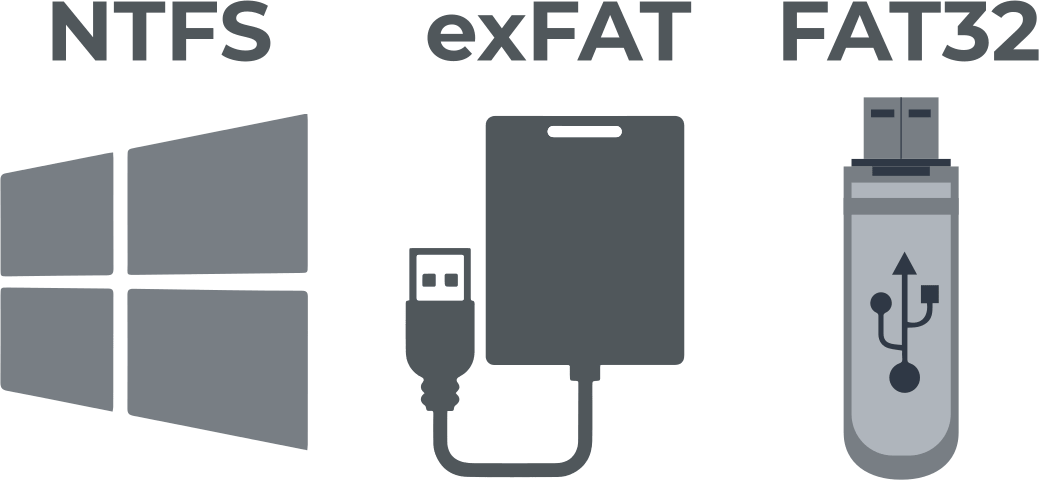FAT32 vs ExFAT vs NTFS comparison

Here you will find out:
- about file systems
- how DiskInternals can help you
Are you ready? Let's read!
About NTFS, FAT32, exFAT
When formatting any disk (external or internal), you are offered a choice of using one of three different file systems: NTFS, FAT32 and exFAT. However, you will not receive more detailed information and will not know the difference between these file systems. Therefore, before formatting the disk, you should familiarize yourself with these file systems in more detail and choose the one that is more suitable for you.
In general, any file system is a way of organizing a disk. This means that the file system is about distributing files (certain data is stored on disk, and other types of information can be attached to files, etc.).
Windows offers you three different file systems to use:
NTFS is the newest file system used for the system drive and, by default, for most non-removable drives.
FAT32 is a legacy file system, with no additional feature set, but more compatibility with other operating systems.
ExFAT is the most compatible file system with other devices and OS, replacing FAT32.
However, its popularity is not as wide as that of FAT32.
NTFS
NTFS is the file system that is often the default or recommended file system in Windows.
This file system was first introduced with Windows NT, and became available for users with Windows NT.
NTFS theoretically has limits on the size of files and partitions, but there is no evidence that anyone has encountered them.
NTFS contains many advanced features that other file systems do not have. Some of them are:
- file access rights support for security,
- the presence of a change log, which can help you quickly recover the system if a computer failure,
- availability of shadow copies for backups,
- encryption,
- limiting disk quotas,
- hard links and more.
If your Windows system partition must be NTFS, then all additional Windows drives must be with the same file system. This suggests that NTFS compatibility is questionable. You can have any version of Windows, but compatibility with other operating systems will be limited. As for Mac OS X, NTFS will only be able to read disks, not write to them. Some Linux distributions will be read-only, and some may include NTFS write support. Sony PlayStation, Xbox 360 do not fully support NTFS (except for the new Xbox One). You don't even need to talk about other devices, they are unlikely to support NTFS.
FAT32
FAT32 is the "old lady" file system that was introduced back in Windows 95 to replace FAT16.
However, over the years, FAT32 has not only disadvantages, but also advantages. Even modern flash drives are often FAT32 file systems. Ask why? The answer is simple: for maximum compatibility not only with modern computers, but also with other devices. This file system works with all versions of Windows, Linux, Mac, game consoles and almost anything with a USB port.
Limitations and disadvantages are also present: the maximum file size is 4 GB, the maximum partition size is 8 TB. Therefore, using FAT32 is acceptable on removable drives where you need maximum compatibility, provided that you do not have files of 4 GB or more.
Note: on modern versions of Windows, you can no longer install on a FAT32 formatted drive. They must be installed on NTFS formatted drives.
exFAT
The exFAT file system was introduced in 2006 and was added to older versions of Windows and optimized for flash drives.
ExFAT does not have the same file or partition size restrictions as FAT32 and is more compatible than NTFS. We can say that this is the ideal middle ground between FAT32 and NTFS, but still, it is not as widespread as NTFS. Mac offers full read as well as write support for exFAT. Linux can also access the disks by installing the appropriate application. PlayStation 4 and Xbox One support exFAT.
Protect your data
If you formatted the drive and then need data from it, you have a chance to get it back. Just do it as soon as possible, data overwriting won't wait for you. You need to download and install on your computer DiskInternals Uneraser.
This software works with Windows, including 7,8,10 and others, and also supports file systems: UFS, FAT32, ReFS, HFS, NTFS, ReiserFS, Reiser4, XFS Ext2, Ext3, Ext4. You can download the fully functional free trial version and enjoy the whole recovery process and viewing the found data. The recovery wizard in this program opens by default in the welcome window and follows the entire recovery process, so don't worry. As you can see, there are no hopeless situations, especially if you have a tool like DiskInternals Uneraser.
Instructions for DiskInternals Uneraser data recovery tool:
- Stage 1. Preparing for disc recovery. Launch DiskInternals Uneraser. The Recovery Wizard will start automatically, then use it for preparatory work: select the device and file format to scan.
- Stage 2. Scanning and preview. Select your preferred file formats to search, or skip it and click Next. Scanning will start; wait diligently for the end of the promotion. Then start browsing the found right-clicking it, then click on "Preview in new window". This action will give you confidence in the integrity of your data.
- Stage 3. Recovery and export. The recovery itself occurs automatically after you have viewed the file, you will not notice it. In addition, the program recovers files with original names, which can be saved to any media immediately after purchasing a license on the site.
